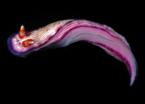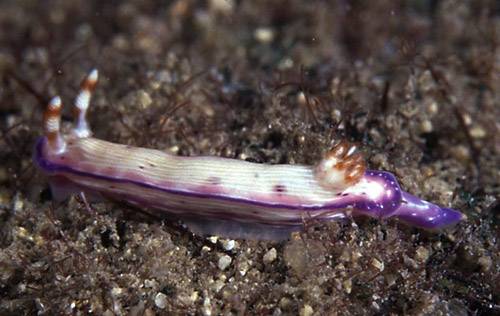| Home |
| Acknowledgments |
| Conventions |
| Glossary |
| Maps |
| References |
| Links |
| Articles |
| Thumbnails |
| Species
list |
| Family |
| Next
species |
Additional Photos

underside

dark

confluent pigment

unspotted

heavily spotted

young

on food sponge

with egg mass
_______________
GALLERY

Hypselodoris peasei (Bergh, 1880)

| Maximum size: 20 mm. Identification: This species is small and elongate with many parallel white longitudinal lines on its light cream to peach notum. The notum may be variably spotted with blue-black. A deep blue or violet line encircles the mantle margin and the edge of the foot. The rhinophores are white with two orange bands and the gills are white with varying amounts of orange on the outer surface. The rhinophore banding is variable in very young animals and the orange pigment may be confluent on the anterior margins of the rhinophores in old animals. Natural history: Hypselodoris peasei is a common, diurnal species that is often found in groups feeding on the yellow sponge Luffariella sp. It occurs in a variety of rocky habitats, as well as in Halimeda kanaloana beds, and has been found in protected to exposed locations from 2-64 m (6-209 ft). The white egg masses are often found on or near the sponge and typically consist of about two whorls. Distribution: Big Island, Maui, Lanai, Oahu, Kauai and Niihau. Taxonomic notes: This species was listed as “locusts” in Bertsch and Johnson, 1981 and was described as Hypselodoris andersoni in Bertsch and Gosliner (1989). It is listed under that name in Hoover, 1998. It seems possible that Doris prismatica var. lineata Pease, 1860 was this species rather than Hypselodoris bertschi as suggested in Kay, 1979. In that case, it was first reported from Hawaii in Pease, 1860. It was named for William Harper Pease who described and recorded over 300 species of Hawaiian mollusks. It's referred to as "Anderson's nudibranch" in Hoover, 1998 and as the "locust nudibranch" in Hoover, 2006. (Note 1) Photo: John Hoover: Magic Island, Oahu; Oct., 1997. Observations and comments: Note 1: Due to variation in rhinophore pigmentation and mantle gland distribution, there's some chance that more than one species is being lumped under this name. |
| Thumbnails |
Species
list |
Family | Next species | Top |